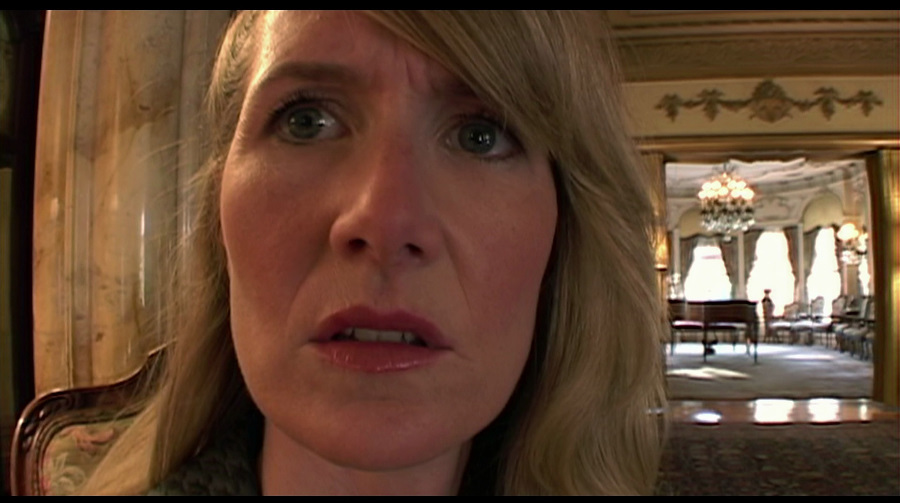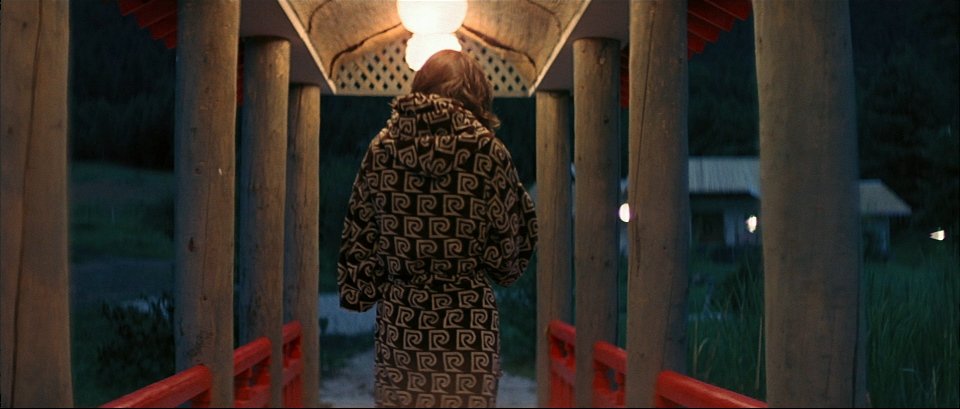There are very few films that deserve to be filmed in 3D. I can probably count them on one hand. This one absolutely belongs on that list. I’m so glad I didn’t settle for watching it in 2D. In other films, dance is merely about motion. Here I kept thinking about sculpture. You see every muscle and really understand what it physically takes to perform these pieces. And it’s not just filmed theater either. As trite as it might sound, Wenders’ angles make you part of the dance. Hopefully one day I can see this projected on a big screen.
Showing posts with label experimental. Show all posts
Showing posts with label experimental. Show all posts
Thursday, December 14, 2017
Monday, June 5, 2017
Inland Empire (2006)
On a recent rewatch of Mulholland Drive, I was observing how many scene transitions were simply hard cuts. One minute we are with one set of characters and the next we are with a whole new group of characters. We have no clue if they are connected but we go along with it. In-between those two scenes is where the cinema of David Lynch resides. We are shown one image and then another and it is up to us to make or find the connections and divine meaning.
Having been filmed in pieces over years, Inland Empire stretches that premise nearly to the breaking point. Lynch himself didn't even know he was making a feature until well into production. He'd come up with an idea for a scene and film it, then a few days or weeks later he'd have a new idea and film that. There was no finished script, the actors had no context of what came before or after. There's even an additional 90 minutes of unused footage this is available as DVD bonus material.
Unlike Mulholland Drive and Lost Highway, I have yet to hear anyone give a coherent "reading" of this film and I don't think it's really even possible to give one. It's an immense collage of pain and sorrow (garmonbozia?) peppered with the occasional dance number. It's not a Disneyland ride with a narrative throughline. Inland Empire is one of those carnival spook-houses where shit just pops out at you. You don't wonder how The Creature from the Black Lagoon got to Transylvania, you just go along for the ride and have an experience.
Labels:
craig,
experimental,
horror,
suspense,
thriller
Thursday, April 6, 2017
Best of Cinerama (1963)
The first Cinerama production was titled, This is Cinerama. But it might as well have been titled This is Cinema because the roots go that deep. The five films compiled to make Best of Cinerama, bear a stronger kinship to the medium's pioneers than they do to Ford or Hitchcock. Part documentary, part travelogue, part amusement park ride, these Cinerama productions feel like the logical successors to the short curiosities and one-offs that the Lumiere Brothers and Edison trafficked in. Can't make it to The Louvre to see The Mona Lisa in its natural setting? Cinerama has you covered! Not tall enough to ride a rollercoaster? Cinerama has you covered! This is Cinema at its most elemental. This is Pure Cinema. And it is glorious.
Labels:
craig,
documentary,
experimental
Thursday, December 8, 2016
Viva (2007)
With its leisurely pace, it's impossible to miss how much work went into this film. To match the specific look Anna Biller and her collaborators were going for, all these period props and costumes had to be found or made. The same goes for the sets and locations. The result is gorgeous to look at and filled with bare flesh, but thanks to the presentational acting and blatant sloganeering, it's much closer to Jean-Luc Godard than Russ Meyer. Biller wants us to take something away from this film. Like Guy Maddin, she's using the form of vintage media to deconstruct the artificiality of both the past and the present. You become hyper-aware of the sexism and hypocrisy that was just underneath the surface of the "free love" movement and America in general. With a Trump presidency looming, a film like Viva provides as an uneasy reminder of the "good times" red hats want to get back to.
Labels:
art,
camp,
craig,
erotic,
experimental
Monday, November 14, 2016
The Fits (2016)
As someone who writes about movies, I am constantly trying to "get" what I have just seen. What are the filmmakers trying to tell me? Did it come across? Could it have been stated more clearly? But not all art is meant to be "got". Some art is meant to be experienced. Some art is just there to give you thoughts and feelings. It isn't trying to tell you what to do with those thoughts and feelings. If they wanted you to take a message away from the film they would have written an essay. Instead, they chose to use cameras and actors and sound and editing to make you feel something. And just because it's art, doesn't mean that it is boring. I hope the fact that it is unrated means that adolescents are getting the chance to see this. It will show them that movies can be anything. And so can they.
Labels:
craig,
experimental,
sci-fi
Thursday, February 25, 2016
Experimenter (2015)
No matter how benign the intent might be, all cinema is a social experiment. It has been produced for a specific purpose. Writers, directors, producers, etc. have deliberately designed it to make the audience feel happy, sad, etc. If the viewer becomes aware of the construction, the experiment has failed. Suddenly you are aware of what you are being fed. You are no longer under their emotional sway and can really examine/digest what you are being shown. You can decide whether you agree or disagree with what the filmmakers are presenting you. In the film Stanley Milgram states, “I believe we are puppets with perception, with awareness. Sometimes we can see the strings. And perhaps our awareness is the first step in our liberation.” Michael Almereyda’s decision to stage this film in such a deliberately artificial way is perfectly in keeping with Milgram’s mission. Since the filmmakers cannot interview us about our experience after the fact, we are instead able to interview ourselves from start to finish.
Labels:
craig,
drama,
experimental,
historical
Monday, November 2, 2015
Adaptation. (2002)
Though his filmography is still so small, the overall emotion I take away from the work of Spike Jonze, is a fear of inadequacy. In Being John Malkovich, you have a protagonist who is so desperate to be anyone but himself that it ends up destroying him. In Her, there's a sentient operating system who realizes that she is capable of being more than just some schlub's accessory. The crucial transition point between these two films is Adaptation. It's act two in a three act structure. The only way you get from the destructive fatalism of the first film, to the optimistic transcendence of the latter film, is through the brutally hard fought realizations of this middle film. This is the film about realizing that you don't have to be a rare, Ghost Orchid. This is the film about realizing that it's OK to just be a daisy. Once you have come to terms with who you really are, you're free to move on and do the truly amazing work that nobody ever saw coming.
Labels:
craig,
drama,
experimental
Thursday, April 9, 2015
Sans Soleil (1983)
I really don't know how to accurately describe Sans Soleil. It isn't entirely a documentary since it has scripted narration that is from the perspective of one fictional person to another. But it is also very much not a narrative film. It exists somewhere in between the two styles and creates something that could only have come from the mind of the elusive Chris Marker. The images are so beautiful and the ideas so insightful that either could easily exist without the other. But it is the ways in which they merge and play off one another that makes this film so truly wonderful. What could have been an above average TV travel special or NPR segment, instead becomes a fascinating examination of memory and one of the most unique cinematic experiences you will ever have. When you or I go on vacation, we come back with a few photos and maybe one interesting story. Chris Marker comes back with a masterpiece.
Labels:
craig,
documentary,
experimental
Thursday, February 26, 2015
The Man Who Fell To Earth (1976)
*** Spoiler Alert ***
The story of this film is insanely simple. It could be related in a single sentence: An alien comes to earth in order to save his family, gets distracted by booze and television and fails at his mission. In the hands of the great Nicolas Roeg, what could have been enough for an above-average episode of The Twilight Zone, instead becomes a decades spanning epic. By stretching the run time to over two hours, we get to become David Bowie's starman. We get to live through a narrative that gradually becomes more muddied, complex and distracting. With a less talented filmmaker, this could have become insufferable. But thanks to all the interesting ideas and images Roeg and his collaborators were able to dream up, we too gradually begin to forget where we began and just go with the dreamy flow. Tommy's loss is our gain.
Labels:
craig,
experimental,
sci-fi
Thursday, May 1, 2014
Under The Skin (2014)
In screenwriting classes you're taught that the first fifteen pages are very important. This is where you set up your world. You let your audience know what the rules are and what to expect from the rest of the film. The same is true of a film's visual and aural aesthetics. By beginning this film with zero dialogue, director Jonathan Glazer is conditioning his audience to rely on their inborn ability to comprehend visual and aural cues rather than falling back on the old crutch of having to spoon-feed them everything through clunky dialogue. But don't worry, if you're really watching this film you will absolutely, "get it". Sure you may have some questions, but questions are good. Talk about them with a friend. The best films are the ones worth talking about and I plan on talking about this one for quite some time.
Labels:
craig,
experimental,
sci-fi
Thursday, October 31, 2013
Red Desert (1964)
After a car accident and a brief stay in a clinic, a woman (Monica Vitti) has become increasingly sensitive to the environment of the industrial town that she lives in.
* * *
Long ago humankind had to adapt to its environment. Nature was harsh and cruel and we as a species evolved to survive. Eventually we gained the ability to adapt our environment to us. Thanks to scientific advancement we can now literally pave paradise and put up a parking lot, or a strip mall, or a nuclear power plant. We are now the masters! Or are we? What does being surrounded by all this artificiality do to a person? All this noise and pollution has to have an effect doesn't it? Like white moths who turn grey to match the trees stained with ash from a local factory, are we too are changing in subtle ways to match our increasingly sick and contaminated environment?
Call Michelangelo Antonioni boring all you want, this film is a subjective masterpiece. Through careful use of sound, composition and color, he is able to put us right in Giuliana’s stylish shoes. This film works a spell on you. When it’s over, you cannot help but feel uneasy about the world you live in. Green Peace should use it as a recruitment film.
Labels:
art,
craig,
experimental,
italy
Monday, October 21, 2013
Blood For Dracula (1974)
Desperately in need of virgin blood, Count Dracula (Udo Kier) travels to Italy in hopes that the country's Catholicism will provide him with the purity that he so craves.
* * *
I think what I like most about film is the ways in which it can show you the world from someone else's point of view. Films coming out of the middle-east and the third world can give us a glimpse at how others see the world. It can be quite surprising to discover that you share a worldview with someone you feel so geographically separated from. Potentially even more illuminating is the discovery that someone you share a homeland with, sees things in quite a different way than you. This is what draws me to the cinema of Paul Morrissey.
With how closely affiliated Morrissey is with Andy Warhol's Factory of the 60's, you'd think that he would be some sort of super-permissive, amoral, hedonist. Yet you couldn't be further from the truth. The real Paul Morrissey is a devout Catholic who served in the Army and self-identifies as a right-winger. The first time I watched this film I found it to be a semi-amusing horror-comedy. On this viewing I was able to see it as what the author intended.
In a film that prominently features greedy, promiscuous aristocrats and an abusive, Marxist, rapist, Dracula himself seems practically harmless. He is not the the thing to dread, the coming of the modern world is. That is horror to Paul Morrissey.
Labels:
craig,
experimental,
horror
Monday, June 24, 2013
Upstream Color (2013)
I'm not even going to attempt to describe this one. Just check it out on Netflix Instant.
* * *
While it is never quite able to match the power and paranoia of the opening third, Shane Carruth's Upsteam Color is a cinematic force to be reckoned with. Filmmaking doesn't get much more pure than this. There is hardly any dialogue and absolutely no exposition, yet if you watch closely you will understand. Everything comes from the images and the ways in which they are juxtaposed with each other. It's Soviet montage at it's most basic: Thesis + Antithesis = Synthesis. A simple cut can bring together two disparate elements in a way that clunky dialogue never could. What might have been laughable in prose, becomes poetry in motion. Only cinema can do this. Shane Carruth should be commended for habitually refusing to take the easy way out and for putting the medium through it's paces. What he has achieved is a work that could literally not exist in any other medium. What could have simply been so-so or overwrought science-fiction, instead became high art.
Labels:
craig,
experimental,
indie,
sci-fi
Thursday, December 20, 2012
Holy Motors (2012)
A mysterious man (Denis Lavant) is driven around in a white limo to various "appointments". Inside the limo he applies makeup and prosthetics to become different people.
* * *
This film really reminded me of early (less misanthropic) Godard. From start to finish it is 100% a work of joyous provocation. In fact, it had me giggling and smiling more than most comedies. This may also have had something to do with the elderly couple I knew was a few rows behind me. You could hear a pin drop during the motion-capture scene. I think I would pay admission just to watch that couple for the film's entire run time.
While some parts went on a little too long or got a touch too maudlin, overall it was a wonderful experience. I appreciate when a filmmaker is able to make the medium do that which only it can. Holy Motors is a uniquely cinematic experience that could never exist as anything but as a film. In fact, it's so much a film that it is several films all at once. If this were a just universe, Denis Lavant would get an Oscar nomination for his chameleon-like performance. Too bad this universe is un-just. Perhaps Eva Mendes will get a supporting nod for being able to keep a straight face through that recreation of La Pietà. Vive la Cinema!
Labels:
art,
craig,
experimental,
france
Thursday, April 19, 2012
The Atomic Cafe (1982)
A collage of Cold War imagery that is simultaneously hilarious and chilling.
* * *
Fear is the great motivator. It can make people do all sorts of crazy things. And from roughly 1945 through 1991, America was in a constant state of fear. The overwhelming fear of Communism compelled us as a Nation to do some really horrific things (The Black List) and it also made us do some really hilarious things (Duck & Cover Drills). It's comforting to think that this film is the past and we as a Nation have grown smarter, but then you take a look at post-911 America and realize nothing has changed. They say that, "Those who cannot remember the past are condemned to repeat it." Watch this movie and learn. WAKE UP PEOPLE!
Labels:
craig,
documentary,
experimental
Friday, March 30, 2012
Coffee and Cigarettes (2003)
A series of short films connected by the presence of the titular vices.
* * *
All filmmakers (regardless of skill) have recurrent themes, images and ideas in their work. Alfred Hitchcock's films often center around guilt and mother issues, Michael Bay's work centers around explosions and breasts. Due to the the unavoidable years that elapse between films, these commonalities often go unnoticed by most audiences. But when a filmography is viewed in somewhat rapid succession (say over the course of a week or a year) the similarities become glaring. By placing these 11 shorts back-to-back within a single film, director Jim Jarmusch effectively laid bare all of his interests and obsessions for the world to see.
Labels:
comedy,
craig,
experimental
Friday, August 12, 2011
Scorpio Rising (1964)
In countless interviews Scorsese has credited Kenneth Anger's gay biker masterpiece Scorpio Rising, as being the film that opened his eyes to the endless cinematic uses of pop music. For this alone the film should be forever cherished. But wait there's more! The visuals are unforgettable. Anger really has an eye for iconic (nearly dreamlike) images that wedge themselves in your brain. Richard Linklater even nicked the opening image for School of Rock from here.
Labels:
craig,
experimental,
LGBTQ,
short
Thursday, June 16, 2011
Screen Tests (1964-1966)
When most people think of Andy Warhol, they think of faces. Marilyn, Liz, Mao, etc. In the 70s, commissioned portraits constituted a significant portion of Andy's total output. As beautiful, iconic and intellectually stimulating as some of these paintings are, they're still just surface. There is no emotional connection to the subject. For that you need to see Warhol's the Screen Tests.
The concept was simple: sit someone on a stool, point a light at them, point a camera at them, turn on the camera and let the film run out. But thanks to an inspired decision to project the films in slow motion (16 fps) the result was anything but simple. Even the tiniest motion is rendered epic through the projector. Every movement becomes significant and meaningful. These are not icons, these are human beings.
The concept was simple: sit someone on a stool, point a light at them, point a camera at them, turn on the camera and let the film run out. But thanks to an inspired decision to project the films in slow motion (16 fps) the result was anything but simple. Even the tiniest motion is rendered epic through the projector. Every movement becomes significant and meaningful. These are not icons, these are human beings.
Though Warhol intended these to be screened silently, Plexifilm was recently granted permission by the Warhol Estate to set 13 of the nearly 500 known tests to music. Pretty amazing stuff...and streamable on Netflix.
Labels:
craig,
experimental
Subscribe to:
Posts (Atom)










